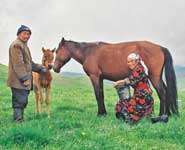Archaeologists find earliest known domestic horses

(PhysOrg.com) -- An international team of archaeologists has uncovered the earliest known evidence of horses being domesticated by humans. The discovery suggests that horses were both ridden and milked. The findings could point to the very beginnings of horse domestication and the origins of the horse breeds we know today. Led by the Universities of Exeter and Bristol (UK), the research is published on Friday 6 March 2009 in leading academic journal Science.
The researchers have traced the origins of horse domestication back to the Botai Culture of Kazakhstan circa 5,500 years ago. This is about 1,000 years earlier than thought and about 2,000 years earlier than domestic horses are known to have been in Europe. Their findings strongly suggest that horses were originally domesticated, not just for riding, but also to provide food, including milk.
Through extensive archaeological fieldwork and subsequent analysis, using new techniques, the team developed three independent lines of evidence for early horse domestication. Their findings show that in the fourth millennium BC horses in Kazakhstan were being selectively bred for domestic use. They also show horses were being harnessed, possibly for riding, and that people were consuming horse milk.
Analysis of ancient bone remains showed that the horses were similar in shape to Bronze Age domestic horses and different from wild horses from the same region. This suggests that people were selecting wild horses for their physical attributes, which were then exaggerated through breeding.
The team used a new technique to search for 'bit damage' caused by horses being harnessed or bridled. The results showed that horses had indeed been harnessed, suggesting they could have been ridden.
Using a novel method of lipid residue analysis, the researchers also analysed Botai pottery and found traces of fats from horse milk. Mare's milk is still drunk in Kazakhstan, a country in which horse traditions run deep, and is usually fermented into a slightly alcoholic drink called 'koumiss'. While it was known that koumiss had been produced for centuries, this study shows the practice dates back to the very earliest horse herders.
Lead author Dr Alan Outram of the University of Exeter said: "The domestication of horses is known to have had immense social and economic significance, advancing communications, transport, food production and warfare. Our findings indicate that horses were being domesticated about 1,000 years earlier than previously thought. This is significant because it changes our understanding of how these early societies developed."
The steppe zones, east of the Ural Mountains in Northern Kazakhstan, are known to have been a prime habitat for wild horses thousands of years ago. They were a commonly hunted animal. This may have set the stage for horse domestication by providing indigenous cultures with access to plentiful wild herds and the opportunity to gain an intimate knowledge of equine behaviour. Horses appear to have been domesticated in preference to adopting a herding economy based upon domestic cattle, sheep and goats. Horses have the advantage of being adapted to severe winters and they are able to graze year round, even through snow. Cattle, sheep and goats need to be to be provided with winter fodder, and were a later addition to the prehistoric economies of the region.
More information: Earliest Horse Harnessing and Milking in the Eneolithic of Prehistoric Eurasia by Alan K. Outram, Natalie Stear, Robin Bendrey, Sandra Olsen, Alexei Kasparov, David Chivall, Victor Zaibert, Nick Thorpe and Richard Evershed, Science
Source: University of Exeter





















